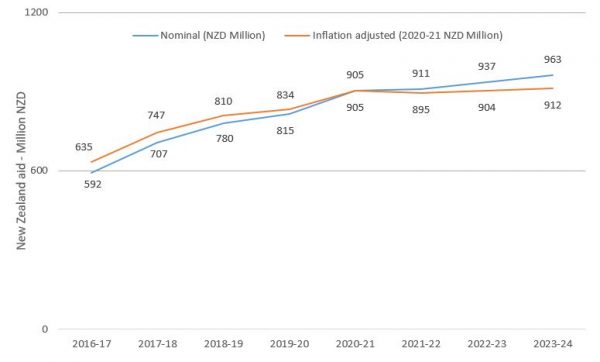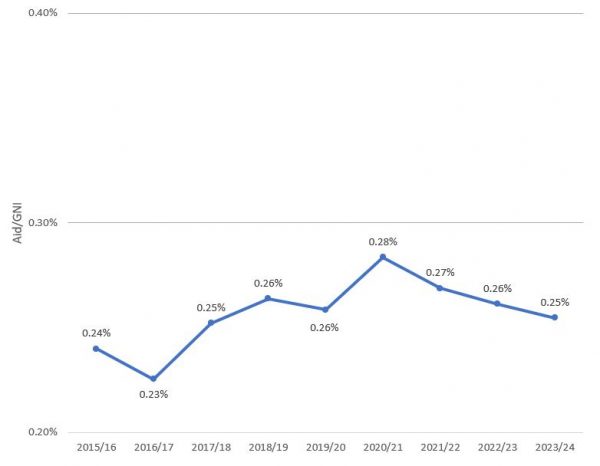
Why New Zealand’s aid budget was better, and worse, than Australia’s
By Terence Wood
28 May 2021
COVID-19 has killed millions of people globally. It has overwhelmed health services. It has brought economies to a standstill. Amidst all this, New Zealand and Australia have been very fortunate so far. Given our good fortune, you would hope we’d be increasing aid, and doing our best to help countries in greater need.
You’d hope, but as Stephen Howes showed in his 2021 budget analysis (read the blogs, or watch his presentation) Australia plans to let its aid fall next financial year and in the two years after that. How about New Zealand? Budget day in New Zealand was 20 May, and it brought a mix of slightly better news, fairly bad news and a vexing problem.
The slightly better news is that while New Zealand aid will also fall next year (once inflation is taken into account), after that it appears as if it will rise. A fall doesn’t sound so good, but it isn’t a dive, and the main source of the fall would seem to be an unexpectedly rapid increase this year. The subsequent rises won’t be huge, but in real terms New Zealand aid appears to be trending upwards over time, even if only slightly. You can see this in the figure below.
The fairly bad news is that New Zealand could be doing better. Aid may be inching upwards, but New Zealand’s economy is forecast to grow at a more rapid rate. More money is available if the New Zealand government wanted to be generous. Apparently, it doesn’t. The consequence can be seen in the next figure – trends in New Zealand’s estimated aid generosity, as measured by aid/GNI. In coming years New Zealand’s aid generosity looks as if it will fall.
By now, a very attentive reader may have guessed the vexing problem with the New Zealand aid budget this year. So far I’ve been using words like ‘appears’ and ‘estimated’. I’ve also used the word ‘aid’, rather than ‘Official Development Assistance’ or its acronym ‘ODA’. There’s a reason for this: New Zealand’s aid transparency is bad, and getting worse.
The New Zealand government makes reams of information available as part of its budget, including projected aid spending for the next financial year. The information on aid isn’t easy to find, but it can be exhumed. Once upon a time, the government also made estimates of future years’ aid spending available (in particular, the years remaining in the triennial cycle over which aid is nominally budgeted). Not anymore though. Although we’re at the start of a triennial aid spending cycle, all that’s provided is information for next year and a lump sum for the triennium – a lump sum that excludes aid overheads. As a result, I’ve had to estimate future aid flows. I’ve done this by dividing the lump sum over coming years and assuming overheads stay the same. My estimates aren’t bad, but someone in the government must have more accurate ones. Why not put them online?
On top of this, Cook Islands, one of New Zealand’s larger aid recipients, is no longer eligible for ODA as per OECD rules. New Zealand still gives aid to Cook Islands, which is fine. It has a special relationship with New Zealand, and needs the money. But funding to Cook Islands is included in our aid budget, which makes it impossible to work out exactly how much ODA New Zealand gives. In practice, it’s not a huge problem: including or excluding Cook Islands doesn’t change high-level totals that much. However, it wouldn’t be an issue at all if the Ministry of Foreign Affairs and Trade (MFAT) did the same as Australia’s Department of Foreign Affairs and Trade and provided country-level budget estimates of aid spending. Australia has issues with budget reporting, but at least it’s possible to get a sense on budget night of where its aid will go. In New Zealand’s case, as I write this, the only available country-level aid information on MFAT’s website is from 2019. The particular problem with Cook Islands may not matter much, but there’s a broader point: New Zealanders should be told where the government plans to spend their aid overseas.
Sure, the information is eventually provided via the OECD but the most recent information on the OECD’s website is also from 2019. Australia does better, New Zealand should too. On budget day, or shortly thereafter, the government should place its estimates of coming years’ aid spending online. It should also provide a country-level aid breakdown, at least for the coming financial year.
And that’s the story of aid in this year’s budget in New Zealand: spending is creeping upwards, but generosity is falling, and transparency is wanting.
Notes
Sources for figures: author calculations. A data pack that contains information on source data, workings, key assumptions and figures is available for download here.
Disclosure
Terence Wood’s research on aid is undertaken with the support of The Bill & Melinda Gates Foundation. The views expressed here are those of the author only.
About the author/s
Terence Wood
Terence Wood is a Fellow at the Development Policy Centre. His research focuses on political governance in Western Melanesia, and Australian and New Zealand aid.


